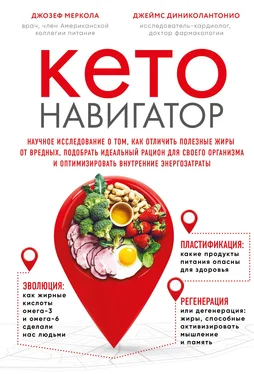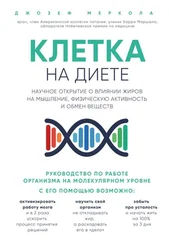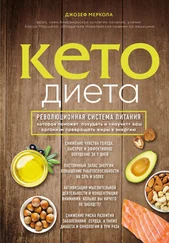16. Lopategi A, Lopez-Vicario C, Alcaraz-Quiles J, et al. Role of bioactive lipid mediators in obese adipose tissue inflammation and endocrine dysfunction. Mol Cell Endocrinol . 2016 Jan 5; 419: 44–59.
17. Там же.
18. Guyenet SJ, Carlson SE. Increase in adipose tissue linoleic acid of US adults in the last half century. Advances in Nutrition . 2015 Nov 1; 6 (6): 660–664.
19. Surette ME, Koumenis IL, Edens MB, et al. Inhibition of leukotriene synthesis, pharmacokinetics, and tolerability of a novel dietary fatty acid formulation in healthy adult subjects. Clin Ther . 2003 Mar; 25 (3): 948–971.
20. James MJ, Gibson RA, Cleland LG. Dietary polyunsaturated fatty acids and inflammatory mediator production. Am J Clin Nutr . 2000 Jan; 71 (1 Suppl): 343s–8s.
21. Manole, Bogdan A. “Effect of Alpha-Linolenic Acid on Global Fatty Oxidation in Adipocytes and Skeletal Muscle Cells” [honors thesis project]. University of Tennessee; 2011.
22. Ikemoto S, Takahashi M, Tsunoda N, et al. High-fat diet-induced hyperglycemia and obesity in mice: differential effects of dietary oils. Metabolism . 1996 Dec; 45 (12): 1539–1546.
23. Hill JO, Peters JC, Lin D, et al. Lipid accumulation and body fat distribution is influenced by type of dietary fat fed to rats. Int J Obes Relat Metab Disord . 1993 Apr; 17 (4): 223–236.
24. Flachs P, Rossmeisl M, Kuda O, et al. Stimulation of mitochondrial oxidative capacity in white fat independent of UCP1: a key to lean phenotype. Biochim Biophys Acta . 2013 May; 1831 (5): 986–1003.
25. Flachs P, Horakova O, Brauner P, et al. Polyunsaturated fatty acids of marine origin upregulate mitochondrial biogenesis and induce beta-oxidation in white fat. Diabetologia . 2005 Nov; 48 (11): 2365–2375.
26. Hensler M, Bardova K, Jilkova ZM, et al. The inhibition of fat cell proliferation by n-3 fatty acids in dietary obese mice. Lipids Health Dis . 2011 Aug 2; 10: 128.
27. Ruzickova J, Rossmeisl M, Prazak T, et al. Omega-3 PUFA of marine origin limit diet-induced obesity in mice by reducing cellularity of adipose tissue. Lipids. 2004 Dec; 39 (12): 1177–1785.
28. Spalding KL, Arner E, Westermark PO, et al. Dynamics of fat cell turnover in humans. Nature . 2008 Jun 5; 453 (7196): 783–787.
29. Azain MJ. Role of fatty acids in adipocyte growth and development. J Anim Sci . 2004 Mar; 82 (3): 916–924.
30. Hutley LJ, Newell FM, Joyner JM, et al. Effects of rosiglitazone and linoleic acid on human preadipocyte differentiation. Eur J Clin Invest . 2003 Jul; 33 (7): 574–581.
31. Alvheim AR, Malde MK, Osei-Hyiaman D, et al. Dietary linoleic acid elevates endogenous 2-AG and anandamide and induces obesity. Obesity (Silver Spring) . 2012 Oct; 20 (1): 1984–1994.
32. Massiera F, Saint-Marc P, Seydoux J, et al. Arachidonic acid and prostacyclin signaling promote adipose tissue development: a human health concern? J Lipid Res . 2003 Feb; 44 (2): 271–279.
33. Moon RJ, Harvey NC, Robinson SM, et al. Maternal plasma polyunsaturated fatty acid status in late pregnancy is associated with offspring body composition in childhood. J Clin Endocrinol Metab . 2013 Jan; 98 (1): 299–307.
34. Donahue SM, Rifas-Shiman SL, Gold DR, et al. Prenatal fatty acid status and child adiposity at age 3 y: results from a US pregnancy cohort. Am J Clin Nutr . 2011 Apr; 93 (4): 780–788.
35. Hill JO, Peters JC, Lin D, et al. Lipid accumulation and body fat distribution is influenced by type of dietary fat fed to rats. Int J Obes Relat Metab Disord . 1993 Apr; 17 (4): 223–236.
36. Su W, Jones PJ. Dietary fatty acid composition influences energy accretion in rats. J Nutr . 1993 Dec; 123 (12): 2109–2114.
37. Baillie RA, Takada R, Nakamura M, et al. Coordinate induction of peroxisomal acyl-CoA oxidase and UCP-3 by dietary fish oil: a mechanism for decreased body fat deposition. Prostaglandins Leukot Essent Fatty Acids .1999 MayJun; 60 (5–6): 351–356.
38. Belzung F, Raclot T, Groscolas R. Fish oil n-3 fatty acids selectively limit the hypertrophy of abdominal fat depots in growing rats fed high-fat diets. Am J Physiol . 1993 Jun; 264 (6 Pt 2): R1111–1118.
39. Kunesova M, Braunerova R, Hlavaty P, et al. The influence of n-3 polyunsaturated fatty acids and very low calorie diet during a short-term weight reducing regimen on weight loss and serum fatty acid composition in severely obese women. Physiol Res . 2006; 55 (1): 63–72.
40. Там же.
41. Thorsdottir I, Tomasson H, Gunnarsdottir I, et al. Randomized trial of weightloss-diets for young adults varying in fish and fish oil content. Int J Obes (Lond) . 2007 Oct; 31 (1): 1560–1566.
42. Mater MK, Thelen AP, Pan DA, et al. Sterol response element-binding protein 1c (SREBP1c) is involved in the polyunsaturated fatty acid suppression of hepatic S14 gene transcription. J Biol Chem . 1999 Nov; 274 (46): 32725–32732.
43. Hulbert AJ, Else PL. Membranes as possible pacemakers of metabolism. J Theor Biol . 1999 Aug 7; 199 (3): 257–274.
44. Allport S. The queen of fats: why omega-3s were removed from the western diet and what we can do to replace them . Oakland (CA): University of California Press; 2006. 232 p.
45. Hulbert AJ, Else PL. Membranes as possible pacemakers of metabolism. J Theor Biol .1999 Aug 7; 199 (3): 257–274.
46. Там же.
47. Smith GI, Atherton P, Reeds DN, et al. Dietary omega-3 fatty acid supplementation increases the rate of muscle protein synthesis in older adults: a randomized controlled trial. Am J Clin Nutr . 2011 Feb; 93 (2): 402–412.
48. Smith GI, Julliand S, Reeds DN, et al. Fish oil-derived n-3 PUFA therapy increases muscle mass and function in healthy older adults. Am J Clin Nutr . 2015 Jul; 102 (1): 115–122.
49. Gingras AA, White PJ, Chouinard PY, et al. Long-chain omega-3 fatty acids regulate bovine whole-body protein metabolism by promoting muscle insulin signalling to the Akt-mTOR-S6K1 pathway and insulin sensitivity. J Physiol . 2007 Feb 15; 579 (Pt 1): 269–284.
50. Alexander JW, Saito H, Trocki O, et al. The importance of lipid type in the diet after burn injury. Ann Surg .1986 Jul; 204 (1): 1–8.
51. Berbert AA, Kondo CR, Almendra CL, et al. Supplementation of fish oil and olive oil in patients with rheumatoid arthritis. Nutrition . 2005 Feb; 21 (2): 131–136.
52. Murphy RA, Mourtzakis M, Chu QS, et al. Nutritional intervention with fish oil provides a benefit over standard of care for weight and skeletal muscle mass in patients with nonsmall cell lung cancer receiving chemotherapy. Cancer . 2011 Apr 15; 117 (8): 1775–1782.
53. Rodacki CL, Rodacki AL, Pereira G, et al. Fish-oil supplementation enhances the effects of strength training in elderly women. Am J Clin Nutr . 2012 Feb; 95 (2): 428–436.
54. Ryan AM, Reynolds JV, Healy L, et al. Enteral nutrition enriched with eicosapentaenoic acid (EPA) preserves lean body mass following esophageal cancer surgery: results of a double-blinded randomized controlled trial. Ann Surg . 2009 Mar; 249 (3): 355–363.
55. Whitehouse AS, Smith HJ, Drake JL, et al. Mechanism of attenuation of skeletal muscle protein catabolism in cancer cachexia by eicosapentaenoic acid. Cancer Res . 2001 May; 61 (9): 3604–3609.
56. Smith GI, Julliand S, Reeds DN, et al. Fish oil-derived n-3 PUFA therapy increases muscle mass and function in healthy older adults. Am J Clin Nutr . 2015 Jul; 102(1): 115–122.
57. Jucker BM, Cline GW, Barucci N, et al. Differential effects of safflower oil versus fish oil feeding on insulin-stimulated glycogen synthesis, glycolysis, and pyruvate dehydrogenase flux in skeletal muscle: a 13C nuclear magnetic resonance study. Diabetes . 1999 Jan; 48 (1): 134–140.
Читать дальше
Конец ознакомительного отрывка
Купить книгу












